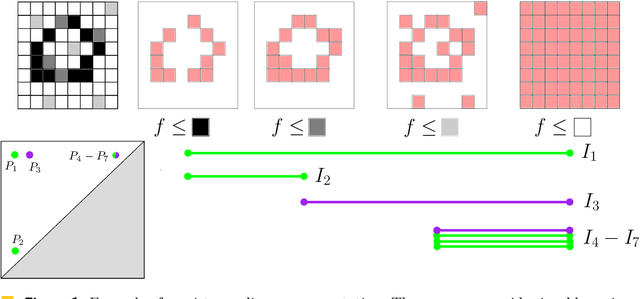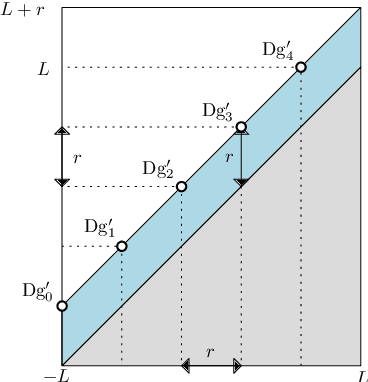Ulrich Bauer
Topograph: An efficient Graph-Based Framework for Strictly Topology Preserving Image Segmentation
Nov 05, 2024



Abstract:Topological correctness plays a critical role in many image segmentation tasks, yet most networks are trained using pixel-wise loss functions, such as Dice, neglecting topological accuracy. Existing topology-aware methods often lack robust topological guarantees, are limited to specific use cases, or impose high computational costs. In this work, we propose a novel, graph-based framework for topologically accurate image segmentation that is both computationally efficient and generally applicable. Our method constructs a component graph that fully encodes the topological information of both the prediction and ground truth, allowing us to efficiently identify topologically critical regions and aggregate a loss based on local neighborhood information. Furthermore, we introduce a strict topological metric capturing the homotopy equivalence between the union and intersection of prediction-label pairs. We formally prove the topological guarantees of our approach and empirically validate its effectiveness on binary and multi-class datasets. Our loss demonstrates state-of-the-art performance with up to fivefold faster loss computation compared to persistent homology methods.
Efficient Betti Matching Enables Topology-Aware 3D Segmentation via Persistent Homology
Jul 05, 2024Abstract:In this work, we propose an efficient algorithm for the calculation of the Betti matching, which can be used as a loss function to train topology aware segmentation networks. Betti matching loss builds on techniques from topological data analysis, specifically persistent homology. A major challenge is the computational cost of computing persistence barcodes. In response to this challenge, we propose a new, highly optimized implementation of Betti matching, implemented in C++ together with a python interface, which achieves significant speedups compared to the state-of-the-art implementation Cubical Ripser. We use Betti matching 3D to train segmentation networks with the Betti matching loss and demonstrate improved topological correctness of predicted segmentations across several datasets. The source code is available at https://github.com/nstucki/Betti-Matching-3D.
Topologically faithful multi-class segmentation in medical images
Mar 16, 2024Abstract:Topological accuracy in medical image segmentation is a highly important property for downstream applications such as network analysis and flow modeling in vessels or cell counting. Recently, significant methodological advancements have brought well-founded concepts from algebraic topology to binary segmentation. However, these approaches have been underexplored in multi-class segmentation scenarios, where topological errors are common. We propose a general loss function for topologically faithful multi-class segmentation extending the recent Betti matching concept, which is based on induced matchings of persistence barcodes. We project the N-class segmentation problem to N single-class segmentation tasks, which allows us to use 1-parameter persistent homology making training of neural networks computationally feasible. We validate our method on a comprehensive set of four medical datasets with highly variant topological characteristics. Our loss formulation significantly enhances topological correctness in cardiac, cell, artery-vein, and Circle of Willis segmentation.
Topologically faithful image segmentation via induced matching of persistence barcodes
Nov 28, 2022Abstract:Image segmentation is a largely researched field where neural networks find vast applications in many facets of technology. Some of the most popular approaches to train segmentation networks employ loss functions optimizing pixel-overlap, an objective that is insufficient for many segmentation tasks. In recent years, their limitations fueled a growing interest in topology-aware methods, which aim to recover the correct topology of the segmented structures. However, so far, none of the existing approaches achieve a spatially correct matching between the topological features of ground truth and prediction. In this work, we propose the first topologically and feature-wise accurate metric and loss function for supervised image segmentation, which we term Betti matching. We show how induced matchings guarantee the spatially correct matching between barcodes in a segmentation setting. Furthermore, we propose an efficient algorithm to compute the Betti matching of images. We show that the Betti matching error is an interpretable metric to evaluate the topological correctness of segmentations, which is more sensitive than the well-established Betti number error. Moreover, the differentiability of the Betti matching loss enables its use as a loss function. It improves the topological performance of segmentation networks across six diverse datasets while preserving the volumetric performance. Our code is available in https://github.com/nstucki/Betti-matching.
On the Metric Distortion of Embedding Persistence Diagrams into Reproducing Kernel Hilbert Spaces
Jun 19, 2018



Abstract:Persistence diagrams are important feature descriptors in Topological Data Analysis. Due to the nonlinearity of the space of persistence diagrams equipped with their {\em diagram distances}, most of the recent attempts at using persistence diagrams in Machine Learning have been done through kernel methods, i.e., embeddings of persistence diagrams into Reproducing Kernel Hilbert Spaces (RKHS), in which all computations can be performed easily. Since persistence diagrams enjoy theoretical stability guarantees for the diagram distances, the {\em metric properties} of a kernel $k$, i.e., the relationship between the RKHS distance $d_k$ and the diagram distances, are of central interest for understanding if the persistence diagram guarantees carry over to the embedding. In this article, we study the possibility of embedding persistence diagrams into RKHS with bi-Lipschitz maps. In particular, we show that when the RKHS is infinite dimensional, any lower bound must depend on the cardinalities of the persistence diagrams, and that when the RKHS is finite dimensional, finding a bi-Lipschitz embedding is impossible, even when restricting the persistence diagrams to have bounded cardinalities.
A Stable Multi-Scale Kernel for Topological Machine Learning
Dec 21, 2014



Abstract:Topological data analysis offers a rich source of valuable information to study vision problems. Yet, so far we lack a theoretically sound connection to popular kernel-based learning techniques, such as kernel SVMs or kernel PCA. In this work, we establish such a connection by designing a multi-scale kernel for persistence diagrams, a stable summary representation of topological features in data. We show that this kernel is positive definite and prove its stability with respect to the 1-Wasserstein distance. Experiments on two benchmark datasets for 3D shape classification/retrieval and texture recognition show considerable performance gains of the proposed method compared to an alternative approach that is based on the recently introduced persistence landscapes.
 Add to Chrome
Add to Chrome Add to Firefox
Add to Firefox Add to Edge
Add to Edge